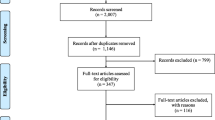Abstract
Complementary and alternative medicine (CAM) is now a major component of healthcare and also a popular choice of treatment for many consumers in a large number of countries. The increasing level of CAM consumption raises a number of important issues of direct relevance to health researchers and practitioners (regarding such topics as potential drug interactions, integrative health service planning and the equity and accessibility of provision of effective treatments). However, there is limited research focusing on the use of CAM and CAM users, and we still know little about CAM consumers and consumption around the world.
In response, this paper outlines four areas for future research in this field: gender and CAM consumption; locality and CAM consumption; health service utilisation and CAM consumption; and motivations, experience and perceptions of CAM users. These four areas offer health researchers one particular framework for further exploration of this neglected field of study.
Similar content being viewed by others
Notes
It is noted that CAM is only one of a selection of terms used to refer to a collection of therapies, medicines and practices not traditionally considered within conventional medical circles (including acupuncture, aromatherapy, chiropractic, herbal medicines, osteopathy and reflexology, among many others). However, it is not our intention to detail the debate regarding nomenclature here. We have used complementary and alternative medicine (CAM) in line with a growing number of commentators in the field.
References
Ernst E. Prevalence of use of complementary/alternative medicine: a systematic review. Bull World Health Organ 2000; 78: 252–7
Eisenberg DM, Davis RB, Ettner SL, et al. Trends in alternative medicine use in the United States, 1990–1997: results of a follow-up national survey. JAMA 1998; 280: 1569–75
Australian Medical Association. AMA position statement: complementary medicine [online]. Available from URL: http://www.ama.com.au/web.nsf/doc/SHED-5FK4V5/$file/healths_gd_ps_compl%20medicine.doc [Accessed 2004 Mar 2]
British Medical Association. Complementary medicine: new approaches to good practice. Oxford: Oxford University Press, 1993
Institute of Medicine. Exploring complementary and alternative medicine. Richard and Hinda Rosenthal Lecture Series. Washington, DC: National Academies Press, 2003
World Health Organization. Traditional medicine strategy. Geneva: WHO, 2002
Bodeker G, Kronenberg F. A public health agenda for traditional, complementary, and alternative medicine. Am J Public Health 2002; 92: 1582–91
Pirotta MV, Cohen MM, Kotsirilos V, et al. Complementary therapies: have they become accepted in general practice? Med J Aust 2000; 172: 105–9
Drew AK, Myers SP. Safety issues in herbal medicine: implications for the health professions. Med J Aust 1997; 166: 538–41
Ni H, Simile C, Hardy AM. Utilization of complementary and alternative medicine by United States adults: results from the 1999 national health interview survey. Med Care 2002; 40: 353–8
Kelner M, Wellman B. Health care and consumer choice: medical and alternative therapies. Soc Sci Med 1997; 45: 203–12
Wiles J, Rosenberg MW. ‘Gentle caring experience’: seeking alternative health care in Canada. Health Place 2001; 7: 209–24
Millar WJ. Use of alternative health care practitioners by Canadians. Can J Public Health 1997; 88: 154–8
Astin JA. Why patients use alternative medicine: results of a national study. JAMA 1998; 279: 1548–53
MacLennan AH, Wilson DH, Taylor AW. The escalating cost and prevalence of alternative medicine. Prev Med 2002; 35: 166–73
Wilkinson JM, Simpson MD. High use of complementary therapies in a New South Wales rural community. Aust J Rural Health 2001; 9: 166–71
Ong CK, Petersen S, Bodeker GC, et al. Health status of people using complementary and alternative medical practitioner services in 4 English counties. Am J Public Health 2002; 92: 1653–6
Thomas KJ, Nicholl JP, Coleman P. Use and expenditure on complementary medicine in England: a population based survey. Complement Ther Med 2001; 9: 2–11
Messerli-Rohrbach V, Schr A. Complementary and conventional medicine: prejudices against and demands placed on natural care and conventional doctors [in German]. Schweiz Med Wochenschr 1999; 129: 1535–44
Scott A. Homeopathy as a feminist form of medicine. Sociol Health Illn 1998; 20: 191–214
Adams J, Sibbritt DW, Easthope G, et al. The profile of women who consult alternative health practitioners in Australia. Med J Aust 2003; 179: 297–300
Australian Medical Workforce Advisory Committee. The medical workforce in rural and remote Australia. Sydney: AMWAC, 1996
Adams J. Direct integrative practice, time constraints and reactive strategy: an examination of GP therapists’ perceptions of their complementary medicine. J Manag Med 2001; 15: 312–22
Weir M. Obligation to advise of options for treatment: medical doctors and complementary and alternative medicine practitioners. J Law Med 2003; 10: 296–307
Daly J, Kellehear A, Gliksman M. The public health researcher: a methodological guide. Melbourne: Oxford University Press, 1997
Bair YA, Gold EB, Greendale GA, et al. Ethnic differences in use of complementary and alternative medicine at midlife: longitudinal results from SWAN participants. Am J Public Health 2002; 92: 1832–40
Lewith G. Clinical research in complementary therapies: principles, problems and solutions. Edinburgh: Churchill Livingstone, 2001
Acknowledgements
The authors have received no funding to assist in the preparation of this manuscript and have no conflicts of interest directly relevant to its contents.
Author information
Authors and Affiliations
Corresponding author
Rights and permissions
About this article
Cite this article
Adams, J., Sibbritt, D. & Easthope, G. Researching the Utilisation of Complementary and Alternative Medicine. Evid-Based-Integrative-Med 1, 169–172 (2004). https://doi.org/10.2165/01197065-200401030-00003
Published:
Issue Date:
DOI: https://doi.org/10.2165/01197065-200401030-00003




